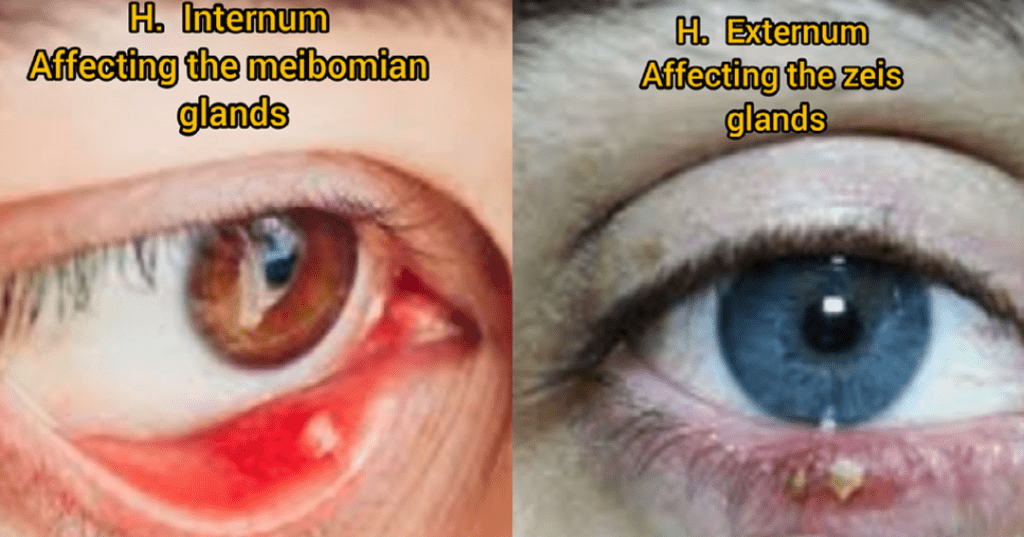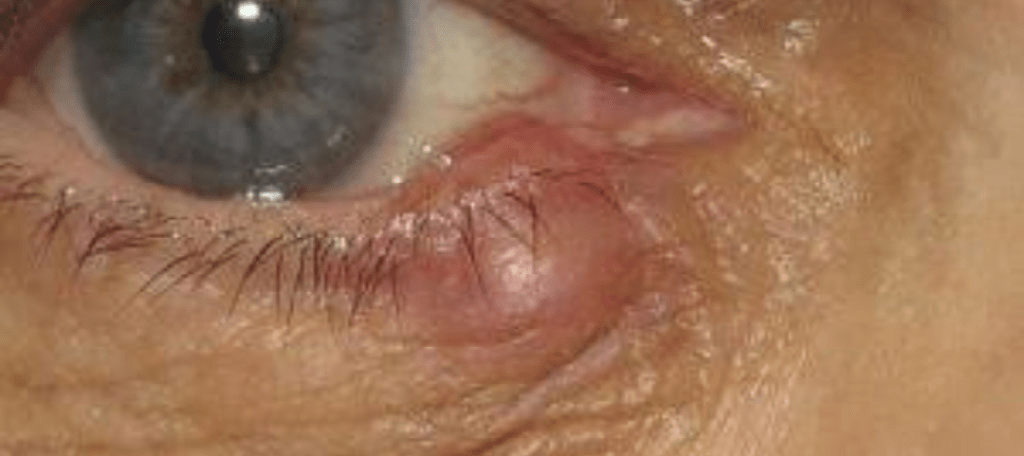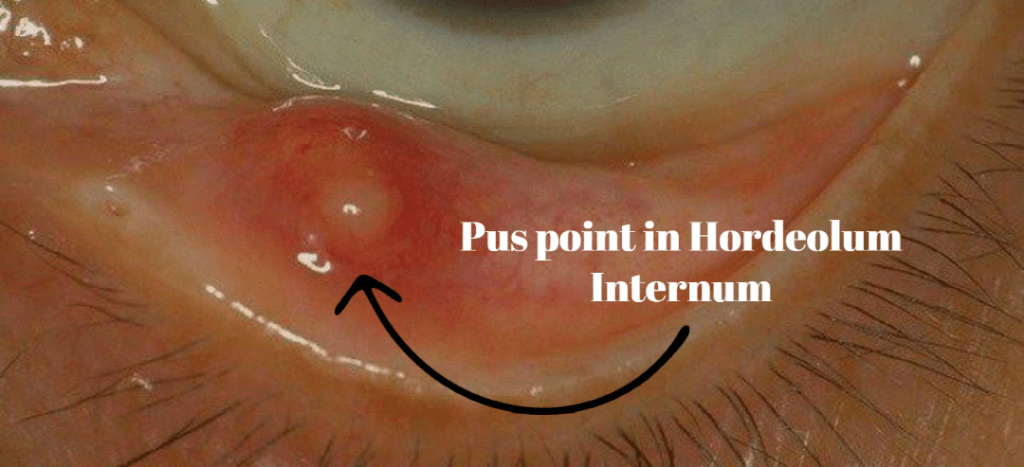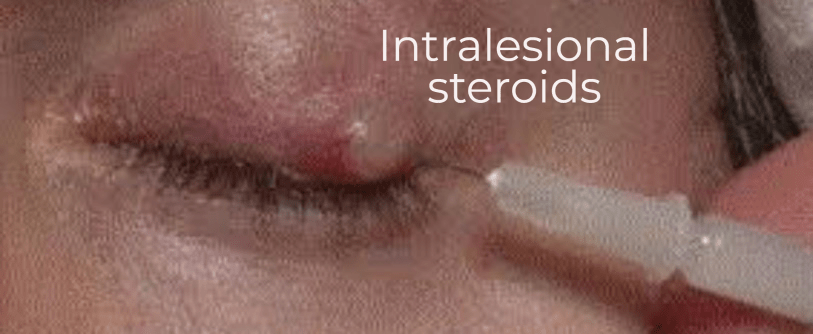A hordeolum, also known as stye, is swelling of the lids caused by an infection, while a chalazion is inflammation of the eyelids that is not infectious.
HORDEOLUM

Staphylococcal infections of Zeis or meibomian glands result in Hordeolum externum or Hordeolum internum respectively. Even though the cause is infectious, hordeolum isn’t contagious. Infection occurs because of blocked glands in the eyelids. It is painful and tender and sometimes even have a pus point. When a pus-filled swelling appears, it may look like a pimple, but never pop it as that might spread the infection, leading to more serious consequences such as preseptal orbital cellulitis, which requires more aggressive treatment.
CHALAZION

Chalazion is an eyelid inflammation caused by secretions trapped in the meibomian gland or zeis gland. Despite the inflammation, chalazion usually does not cause much pain or tenderness.
SYMPTOMS:
- Acute or chronic eyelid lump
- Swelling
- Tenderness
- Burning and irritation
- Foreign body sensation
SIGNS:
- Visible or palpable lump
- Well defined
- Associated tender meibomian gland orifice, acne rosacea or blepharitis.
- Pus point resembling pimple
DIFFERENCE BETWEEN HORDEOLUM (STYE) AND CHALAZION
| Findings | Hordeolum | Chalazion |
| Appearance | Tender and erythematous often times with a pus point | Non erythematous, well defined lump in the eyelid |
| Tenderness | Tender | Usually non-tender |
| Cause | Infection of the the glands of the eyelids. Infection of Zeis (H. Externum) Infection of the meibomian glands (H. Internum) | Inflammation caused by blocked Meibomian and Zeis gland orifices. |
| Location | Superficial, and centered on an eyelash. | Tend to be deeper within the lid when the blockage is in the meibomian gland and on the lid margin when the zeis gland is blocked. |
| Management | Warm compresses/heated eye mask, topical antibiotic +/- steroids, oral antibiotics, pain killers. | Warm compresses/heated eye mask, Oral antibiotics and anti-inflammatory medication |
DIAGNOSIS:
An eye examination and a proper history are sufficient to diagnose these conditions. The patient might have previously undergone ocular surgery or been exposed to trauma, or have had chalazia or a lesion on the eyelid
Examining and palpating eyelid lumps is part of an external eye examination
Examination with a slit lamp includes examining meibomian glands, pressing on them to detect inspissated secretions, and everting the lid to detect lumps.

To rule out other etiologies such as eyelid carcinoma, assess for ulceration on the eyelid and abnormalities with the eyelashes such as whitening or loss of lashes.
MANAGEMENT
Even though the hordeolum and chalazion are not the same but their management are in the same lines.
CONSERVATIVE:
Warm compresses :
As both hordeolum and chalazion are caused by inspissated secretions and blocked orifices, conservative management aims to thin out the secretions to allow them to pass freely.
A week or two of doing this for at least 10 minutes four times a day will give positive results. One can use one of the following methods for warm compresses
- The use of heated eye masks
- Clean washcloths should be soaked in warm water before applying to closed eyelids. Separate washcloths should be used for each eye.
- Put some rice in a clean sock and microwave it for a few seconds. Apply it to your closed eyelids after checking the temperature.
Lid hygiene
- Lid scrubs: Use lid wipes or hypochlorous lid spray and wipe with a clean washcloth along the lid margin. Massaging the lid margins is very important.
- If you wear eye makeup, make sure to clean your lid margin before going to bed
MEDICAL TREATMENT:
1. Hordeolum can be treated with topical antibiotics for 1-2 weeks or with an antibiotic-steroid combination and with low doses of doxycycline for anti-bacterial and anti-inflammatory purposes. In case of chalazion, topical antibiotics do not work, but oral antibiotics and doxycycline can help. Pregnant women, nursing mothers, and children under the age of eight should not take doxycycline.
2. Both Hordeolum and Chalazion can be treated with pain relievers and anti-inflammatory medicines.
2. When the hordeolum worsens, consider incision and drainage and systemic antibiotics for 10-14 days, antibacterial eye ointment and close monitoring.
3. A chalazion that fails to improve within three to four weeks can be treated with an incision and curettage, or with an intralesional (inside the lump) steroid injection.
Incision and Curettage: The area around the lesion is anesthetized by injecting a local anesthetic agent. A special clamp is used to evert the eyelid, then a conjunctival incision is made. Chalazion contents are then scooped out. After the procedure, a pressure bandage is applied to prevent bleeding.

4. According to a study, intralesional TA injections are effective in treating primary and recurrent chalazia. It usually takes 1 to 2 injections to resolve most cases. If 2 or 3 injections fail to treat the chalazia, then surgical excision is likely to be the best option.
5. Chalasia should undergo pathological examination after removal, especially those that recur or are atypical, to rule out other causes.
